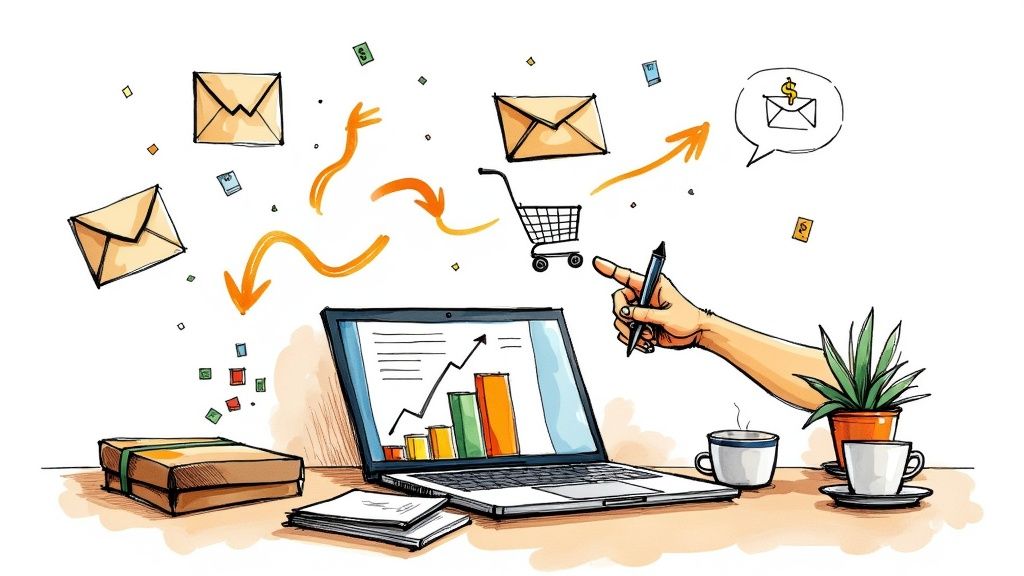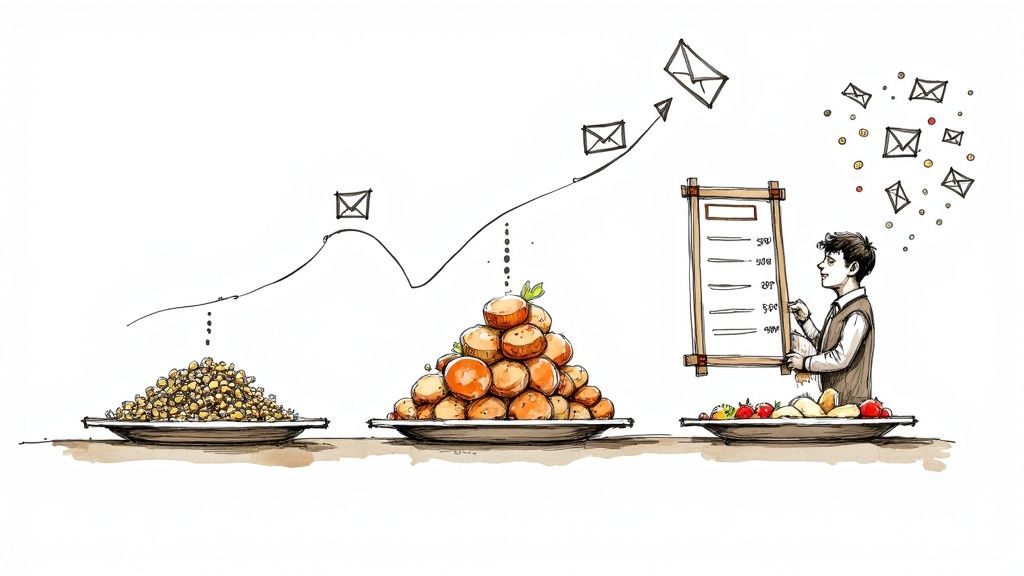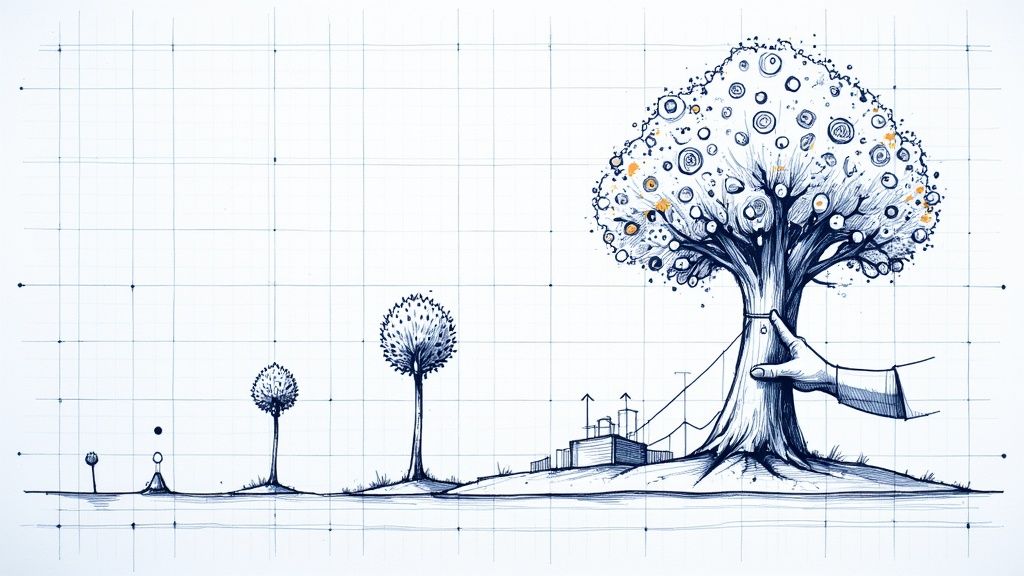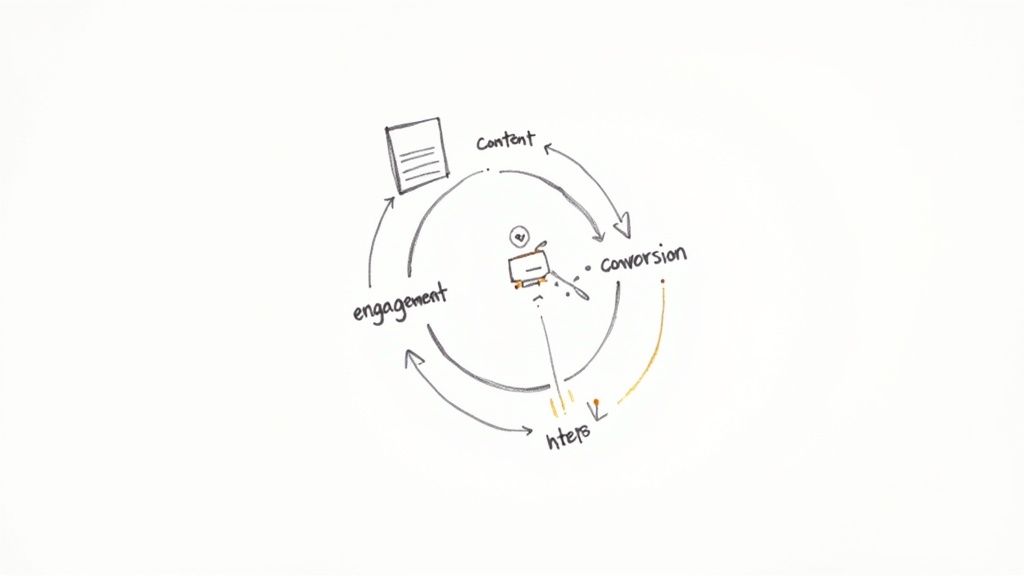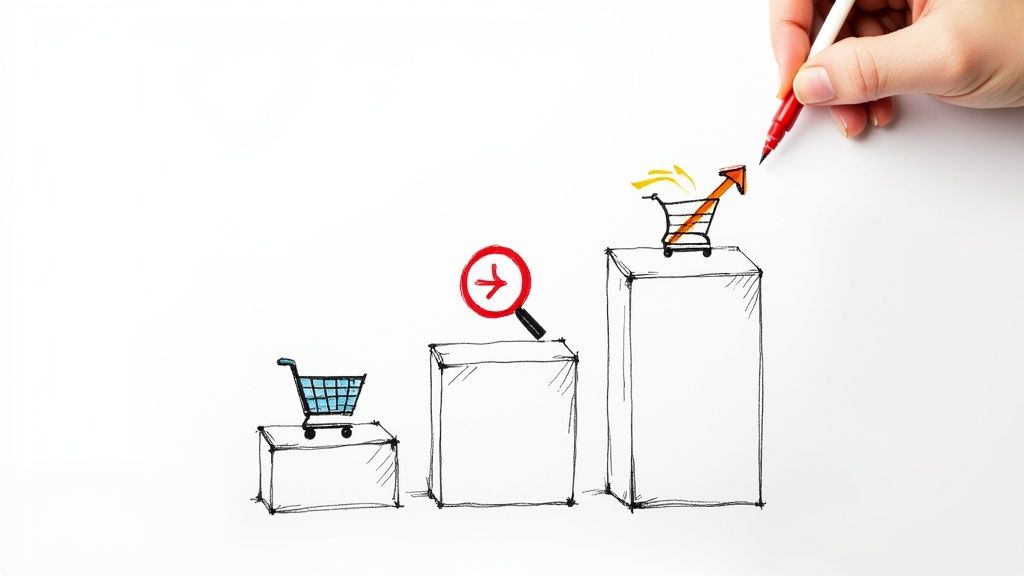6 Proven Email Flows to Boost Sales
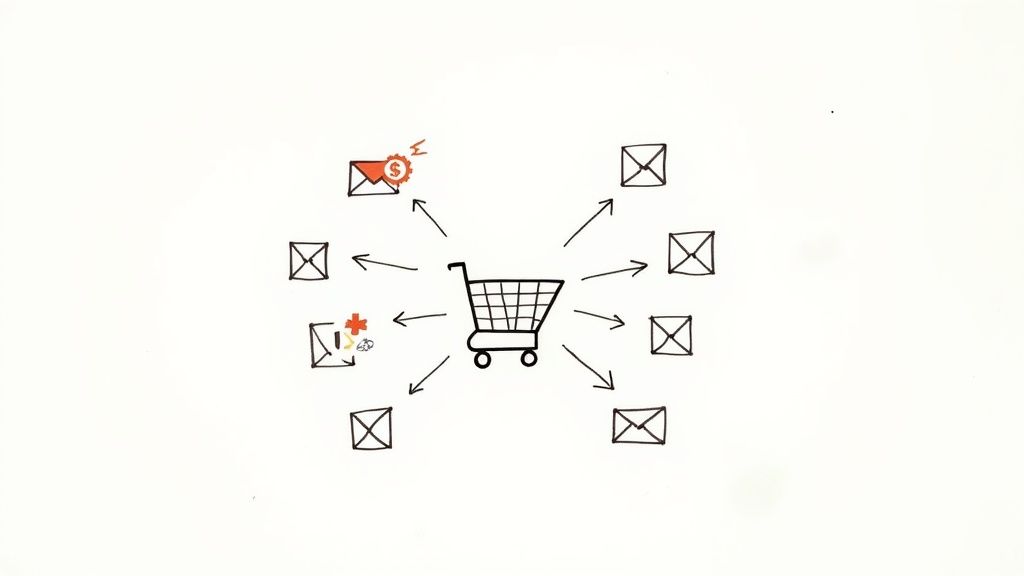
12 mins
5/24/2025
Joe Ervin
- ecommerce email flows
- email marketing
- automation
- online sales
- customer retention
Make More Money with Email
Want more sales without more work? Use ecommerce email flows. These automated emails make money while you sleep. Set them up once and with a few tweaks they'll work forever. Here's my 6 favorite must-have ecommerce email flows: Welcome, Abandoned Cart, Post-Purchase, Browse Abandonment, Win-Back, and Product Replenishment. Learn how to use these flows to boost sales and grow your online store.
1. Welcome Series Flow
A Welcome Series is the first set of emails a new subscriber or customer gets. It introduces your brand and builds a relationship. Think of it like a warm handshake. These 3-5 emails, sent over 1-2 weeks, engage customers when they're most excited. This helps show them who you are and what you offer. A well-crafted welcome series is vital for any ecommerce email flow. It sets the stage for the entire customer journey, and is often the first impression a customer has of your brand after signing up or making a purchase.
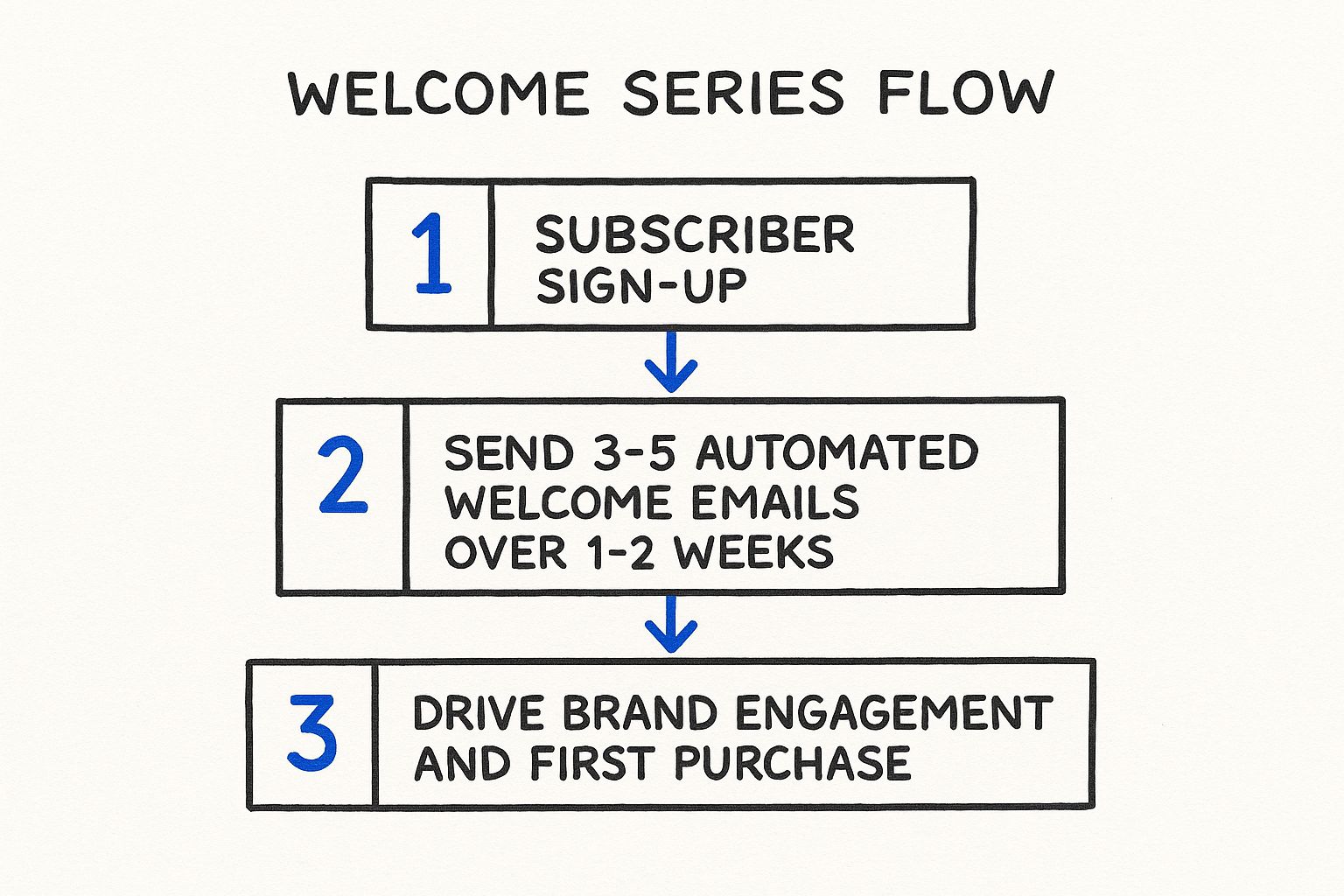
This infographic shows the typical flow of a welcome series, starting with a signup and leading to a purchase. Each step offers valuable information and incentives to guide the customer.
How it Works: A welcome series starts when someone joins your email list or creates an account. Each email shares a bit more about your brand. Many brands offer a perk for a first purchase.
Features:
3-5 automated emails
Starts when someone subscribes or creates an account
Shares brand details step by step
Often offers first purchase discounts
Shows company values
Pros:
High open rates (50-60% on average)
Sets the mood for the customer relationship
Turns subscribers into buyers
Groups subscribers by their actions
Shows your brand's voice
Cons:
Can seem boring if not personal
Too many emails can annoy new subscribers
Needs careful planning to avoid seeming pushy
Examples:
Casper: Uses fun words to tell you about their mattresses.
Sephora: Shares beauty tips and their loyalty program.
Dollar Shave Club: Uses humor and clear words to explain their subscriptions.
Tips for Success:
Say "thank you" in the first email.
Send emails 1-3 days apart.
Share more about your brand in each email.
Tell people what to do in every email (call to action).
Offer a limited-time discount to boost first purchases.
Why This Flow Matters: A welcome series makes a strong first impression. It introduces your brand and turns curious shoppers into loyal customers. This is a key piece of any good ecommerce email flow strategy, particularly for skincare, clothing, and other direct-to-consumer brands.
When to Use It: Start using a welcome series as soon as you can. It's a great way to connect with new subscribers and build a strong customer base from the start.
Learn more about Welcome Series Flow
This flow earns its spot on this list because it’s the best way to make new customers feel welcome and valued. This boosts sales and builds long-term relationships. Popularized by platforms like Klaviyo and Shopify, and brands like Warby Parker, welcome emails are now a cornerstone of ecommerce marketing.
2. Abandoned Cart Flow
One of the most effective ecommerce email flows is the Abandoned Cart Flow. This targets shoppers who add items to their cart but leave your website without buying. These automatic emails remind them about their items. They encourage shoppers to finish their purchase. Often, these emails offer a little extra, like a discount, to sweeten the deal. They might also address why someone left their cart in the first place.
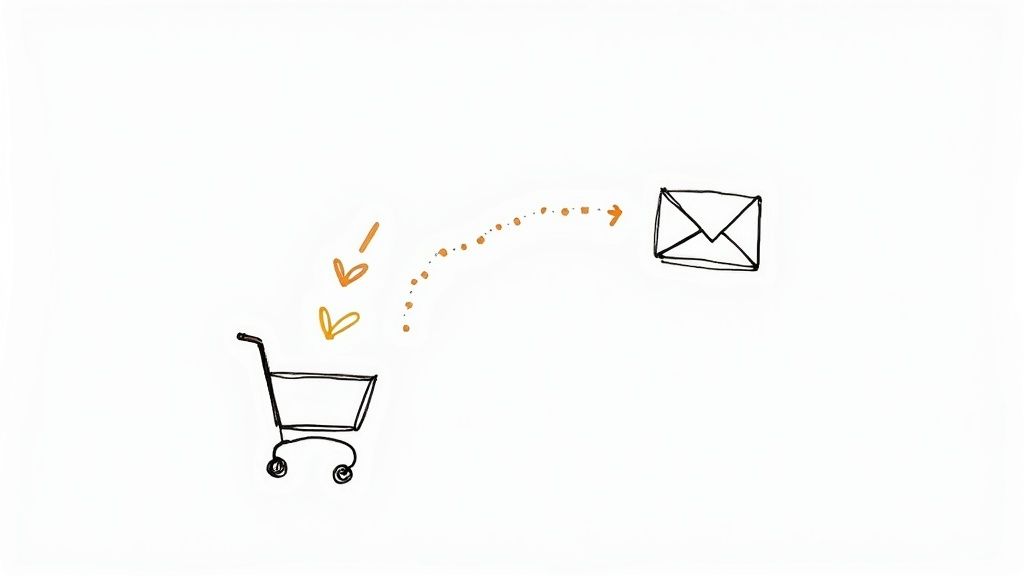
This flow usually sends 2-3 emails over 24-72 hours. The emails show pictures of the items left behind. Later emails might offer a deal. They can also show how popular the items are or remind shoppers that the items might sell out soon. This flow is great because it helps get back lost sales. On average, stores recover 10-15% of abandoned carts. This flow has a high return compared to other emails. It also helps you see why people don't finish buying. You can use this data to improve your store. You can make these emails special for each shopper, showing the exact items they left.
Adidas sends simple reminders with big product pictures and easy checkout links. Bonobos uses funny emails with subject lines like "Hey, you forgot something." Wayfair suggests similar items in their cart recovery emails. These are all excellent examples of abandoned cart emails done right.
You should use an abandoned cart flow if you want to sell more and recover lost sales. It’s important to remember a few things. Send the first email 1-2 hours after someone leaves their cart. This is when they are most likely to buy. Show clear pictures of the items. Add reviews to make shoppers feel confident. Test free shipping against percentage discounts to see what works best. Make the "View Cart" button big and easy to see. Many people shop on their phones, so make sure your emails look good on mobile. Learn more about Abandoned Cart Flow
While Abandoned Cart flows are powerful for ecommerce email flows, there are some drawbacks. Offering discounts might teach some customers to always leave their cart to get a deal. You also need to connect this flow to your online store. Some shoppers might get annoyed if they meant to leave their cart. If you use these emails too much, they become less effective.
3. Post-Purchase Flow
The Post-Purchase flow starts after a customer buys something. It makes customers happy even after they pay. This series of emails confirms orders, sets delivery expectations, asks for feedback, and tries to get repeat business. It turns new buyers into loyal fans.
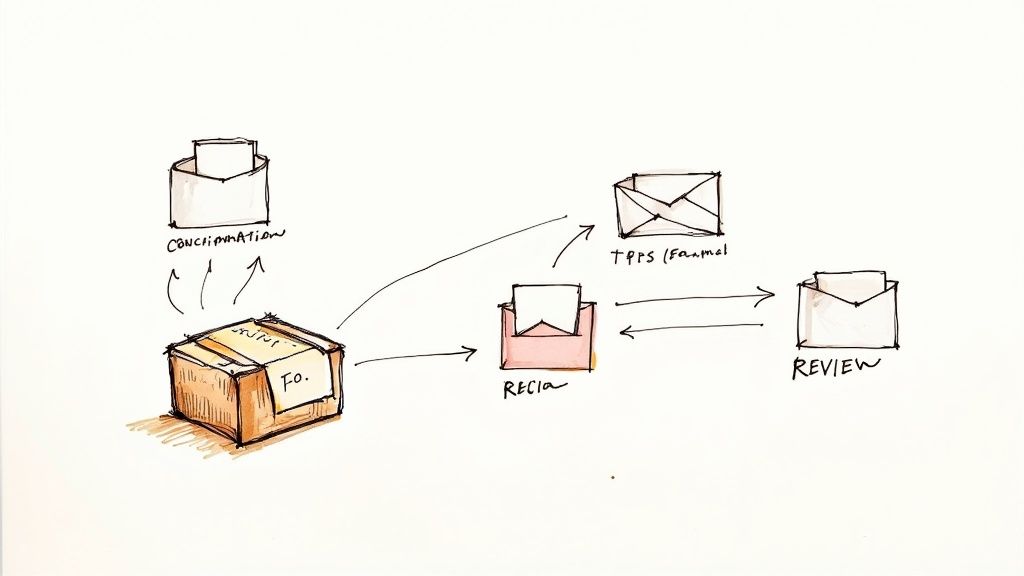
This flow is crucial for any ecommerce email strategy. It builds relationships and boosts sales. It starts with an order confirmation and shipping updates. Then, it offers helpful tips or how-to guides. Later, it asks for reviews. It might also suggest other items or loyalty programs. This process can take days or weeks, matching your typical delivery time.
Examples:
Bellroy (Wallets): Sends tips on product care when the wallet arrives.
Glossier (Makeup): Asks customers to share photos using their products.
Chewy (Pet Food): Sends reminders to reorder food at just the right time.
Pros:
Fewer worried customers contacting support.
Stronger customer relationships.
Valuable reviews and testimonials.
Chances to sell more products.
Higher customer lifetime value.
Cons:
Hard to time emails if shipping is messy.
Can seem pushy if focused only on sales.
Must understand how people use your products.
Emails can bother customers if sent before the item arrives.
Tips for a Great Post-Purchase Flow:
Time emails to match shipping and product use.
Share helpful content so customers get the most from your product.
Ask for reviews 1-2 weeks after delivery, when the product has been used.
Suggest items based on past purchases.
Add marketing messages to order confirmations (almost everyone opens these!).
Offer rewards for joining your loyalty program.
Why This Flow Matters:
The Post-Purchase Flow earns a top spot in ecommerce email flows because it tackles the often-ignored stage after the sale. This flow helps ecommerce businesses, skincare brands, and clothing brands build strong customer bonds and turn single purchases into long-term loyalty. Shopify's post-purchase apps, along with brands like Casper and Away, have shown how powerful this flow can be. Amazon’s review system also demonstrates its effectiveness. Use this flow to make your customers happy, get valuable feedback, and boost your sales.
4. Browse Abandonment Flow
Browse abandonment emails help you connect with shoppers who looked at your products but didn't buy anything. These emails remind shoppers about what they viewed. They work like a gentle nudge, less pushy than a cart abandonment email. This flow deserves a spot on this list because it helps you reach more potential customers earlier in their buying journey. It's a smart way to boost sales.
Here's how it works: A customer looks at a product on your website. They leave without adding it to their cart. Your store sends them an email about that product. This email usually arrives within a few hours or days.
How it helps you:
Captures early interest: You reach shoppers before they even add an item to their cart.
Reaches more people: You can connect with more potential customers than just those who abandon their carts.
Less competition: Fewer stores use browse abandonment emails, so yours stand out.
Answers questions: You can answer questions shoppers might have about a product before they even ask.
Learn about shoppers: You see which products people are interested in.
Things to watch out for:
Tracking: You need good tracking to see which products people view.
Too many emails: Sending too many emails can annoy shoppers.
Lower conversion rates: These emails don't convert as well as cart abandonment emails.
Out-of-stock issues: It’s frustrating for shoppers to get an email about a product that’s no longer available.
Examples:
Framebridge: Sends emails about how their custom framing works for the frames you viewed.
J.Crew: Offers styling tips for the clothes you looked at.
REI: Shares details and reviews about the outdoor gear you browsed.
Tips for Success:
Wait a bit: Wait at least 30-60 minutes before sending the email.
Great pictures: Use high-quality images of the viewed products.
Helpful info: Add details not found on the product page.
Test subject lines: Try subject lines that ask questions. Compare them to subject lines that name the product.
Real reviews: Include reviews about the specific product viewed.
Don’t overdo it: Limit emails for frequent browsers.
Browse abandonment emails are a great way to remind shoppers about the products they liked. By using these tips, you can create effective browse abandonment emails that boost your sales.
5. Win-Back Flow
A Win-Back Flow helps you reconnect with sleepy customers. These are people who haven't bought anything from you in a while (maybe 1-3 months, depending on what you sell). This email series reminds them about your brand and nudges them to buy again. It’s part of smart ecommerce email flows.
Think of it like this: a customer bought a face cream from your skincare brand three months ago. They loved it! But life gets busy, and they forget to order more. A Win-Back Flow sends them a few friendly emails. Maybe the first email says, "We miss you!" The next email might show new face serums. The last email could offer a discount.
This approach works because it's much cheaper to get an old customer to buy again than to find a brand new one. Plus, winning back lost customers keeps your email list clean.
Here's how it works:
Triggers: The flow starts when a customer hasn't bought anything for a set time.
Emails: You send 3-5 emails over a few weeks.
Deals: You can offer bigger and bigger discounts in each email.
New Stuff: Show off new products or updates.
Feelings: Remind them why they liked your brand in the first place.
Good things about Win-Back Flows:
Brings back lost customers.
Costs less than finding new ones.
Helps you learn why people stop buying.
Cleans up your email list.
Not-so-good things about Win-Back Flows:
Big discounts can shrink your profits.
Customers might wait for discounts.
Bad timing can annoy people.
Too many ignored emails can hurt your sender score.
Examples:
Grammarly reminds inactive users about cool features they haven't tried.
Sephora gives bonus points to members who haven't shopped lately.
Blue Apron tempts old customers back with special meals and deals.
Tips for Success:
Group Customers: Treat your best customers differently than one-time buyers.
Catchy Subjects: Use titles that make people want to open the email.
Test What Works: See if emotional messages or discounts work better.
"We Miss You": Start with a friendly reminder before offering deals.
More than Email: Use ads along with your emails.
Easy Unsubscribe: Make it simple for people to leave if they want.
Timing is Key: Figure out how often people buy your products and time your emails right.
Learn more about Win-Back Flow
Win-Back Flows deserve a spot in every ecommerce email plan. They’re a smart way to revive sales from quiet customers. Whether you sell clothes, skincare, or anything else online, winning back lost customers is key to growth. Using a well-designed Win-Back Flow is a proven method to achieve this, making it an essential tool for any online business.
6. Product Replenishment Flow
A Product Replenishment flow helps you sell more. It reminds customers to buy again when they likely need more. This works best for things people use regularly. Think beauty products, vitamins, pet food, or anything else that runs out. This flow makes reordering easy and fast. This keeps customers happy and coming back. It's a key part of smart ecommerce email flows.
This flow starts when a customer buys something that needs refilling. The system guesses when they'll run out. It then sends a few emails as that time gets close. These emails usually offer one-click buying. They might also suggest a subscription. Subscriptions let customers get regular deliveries without reordering each time.
Examples:
The Honest Company sends diaper reminders based on baby's age and diaper size.
Sephora reminds you to buy new mascara after 3 months.
Who Gives A Crap sends funny toilet paper refill emails when you're about to run out.
Why use this flow?
Product Replenishment flows create steady sales. They help you keep customers longer. They stop customers from going to other stores. They also show you care. They are a great way to sell related items, too. You can even turn one-time buyers into subscribers.
Good things:
Makes sales predictable
Keeps customers coming back
Stops customers from going to other stores
Shows you care about your customers
Great for selling more items
Helps turn one-time buyers into subscribers
Not-so-good things:
Needs good data on how fast people use your products
Might not work if people use products at different rates
Can bother people if the timing is wrong
Needs good product tags and order tracking
Tips for Success:
Study past orders to see how long products last.
Send the first reminder about a week before they run out.
Show pictures of what they bought before.
Make buying again super easy (one-click is best).
Try offering deals for subscriptions.
Share reviews about how easy subscriptions are.
If a product's usage varies, let customers set their own refill schedule.
Made Popular By:
Amazon's Subscribe & Save
Dollar Shave Club subscriptions
Ritual vitamin subscriptions
Product Replenishment flows are a powerful tool for any ecommerce business. They boost sales, improve customer loyalty, and simplify the buying process for repeat purchases. This makes them a vital part of your overall ecommerce email strategy.
Ecommerce Email Flows Comparison Matrix
Email Flow | Implementation Complexity 🔄 | Resource Requirements 💡 | Expected Outcomes 📊 | Ideal Use Cases 💡 | Key Advantages ⭐ |
|---|---|---|---|---|---|
Welcome Series Flow | Moderate – requires sequence setup and segmentation | Moderate – content creation for 3-5 emails and personalization | High engagement with open rates of 50-60%, first purchase conversion | New subscribers or customers just joined | Establishes brand identity, highest open rates, builds relationships |
Abandoned Cart Flow | Medium to High – integration with e-commerce platform needed | Moderate – product images, customer data integration | Revenue recovery up to 15%, immediate purchase intent captured | Shoppers who added items but didn’t checkout | Directly recovers lost sales, high ROI, personalized reminders |
Post-Purchase Flow | Moderate – requires timing aligned with shipping and usage | Moderate – content for confirmations, education, reviews requests | Increases customer lifetime value, generates reviews and repeat purchases | Customers post order completion | Reduces anxiety, drives loyalty, cross-sell and upsell opportunities |
Browse Abandonment Flow | High – requires sophisticated tracking and real-time inventory sync | High – behavioral tracking, dynamic content, inventory data | Lower conversion (2-5%), expands audience beyond cart abandoners | Visitors who viewed products without carting | Captures early-stage interest, provides product insights, less competitive |
Win-Back Flow | Moderate – timing based on inactivity and segmentation | Moderate – multi-step content & incentives needed | Reactivates dormant customers, improves customer lifetime value | Inactive or dormant customers | Cost-effective reactivation, feedback collection, churn reduction |
Product Replenishment Flow | High – needs accurate consumption data and purchase tracking | High – data analysis, dynamic timing, potential subscription integration | High conversion (25-40%), predictable recurring revenue | Consumable products with predictable usage | Drives predictable revenue, increases loyalty, enables subscriptions |
Stop Guessing, Start Growing
This article covered six key ecommerce email flows. These flows work for all kinds of online stores, from skincare to clothing. They help you connect with shoppers at every step. Use them to welcome new customers, recover lost sales, and reward loyal fans.
Here's a quick recap:
Welcome Series: Greet new subscribers and turn them into buyers.
Abandoned Cart: Remind shoppers about items left in their cart.
Post-Purchase: Thank customers and offer related products.
Browse Abandonment: Reach out to shoppers who viewed products but didn't buy.
Win-Back: Reconnect with inactive customers.
Product Replenishment: Remind customers to reorder items they use regularly.
These ecommerce email flows help you sell more, keep customers happy, and grow your business. You want your emails to speak directly to each customer, right? If so, explore email marketing personalisation to fine-tune your messages for even better results.
Setting up these flows can seem like a lot of work. But it's worth it. These automated emails work 24/7. They connect with your customers, build trust, and boost sales.
Trace Branding can help set these flows up for you. We make emails, campaigns, and content that work together. Visit our website to learn more.
